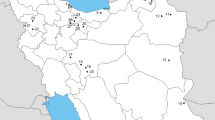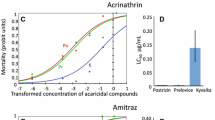Abstract
Varroa destructor is the major cause of honey bee (Apis mellifera) colony losses. Mite control is limited to several miticides. The overuse of tau-fluvalinate has resulted in resistance via a knockdown resistance (kdr) mutation in the sodium channel gene NaVChs (L925V/I/M). In this study, we used the discriminating concentration of tau-fluvalinate (0.25 µg/mL) to detect the resistance of mites in a bioassay. Further, we verified the presence of the kdr mutation in mites from the bioassay via PCR amplification of a fragment of the voltage-gated sodium channel gene (NaVCh), restriction fragment length polymorphisms (RFLPs), and densitometry analyses in pools of surviving or dead mites. Resistance values corresponding to the densitometry of the resistant allele were related to mite survival. In the vial test, the survival of the control group was significantly higher (70.4%) than that of the tau-fluvalinate-treated group (34.3%). Mite survival in the vial test was significantly correlated with the mean proportion of resistance values. Individuals that died after tau-fluvalinate application exhibited an average resistance value of 0.0783, whereas individuals that survived exhibited an average resistance of 0.400. The concentration of tau-fluvalinate in the vials was checked using high performance liquid chromatography under different temperatures and exposure times, and indicates that the stability of tau-fluvalinate stored in the refrigerator (4 ± 1 °C) is at least 14 days. PCR–RFLP of the NaVCh gene fragment verified that the vial test is a suitable, rapid, and cost-effective method for the identification of tau-fluvalinate resistance based on kdr mutation in V. destructor in apiaries.

Similar content being viewed by others
References
Alissandrakis E, Ilias A, Tsagkarakou A (2017) Pyrethroid target site resistance in Greek populations of the honey bee parasite Varroa destructor (Acari: Varroidae). J Apic Res 56:625–630. https://doi.org/10.1080/00218839.2017.1368822
Bak B, Wilde J, Siuda M (2012) Characteristics of north-eastern population of Varroa destructor resistant to synthetic pyrethroids. Med Wet 68:603–606
Beaurepaire AL, Krieger KJ, Moritz RFA (2017) Seasonal cycle of inbreeding and recombination of the parasitic mite Varroa destructor in honeybee colonies and its implications for the selection of acaricide resistance. Infect Genet Evol 50:49–54. https://doi.org/10.1016/j.meegid.2017.02.011
Bonzini S, Tremolada P, Bernardinelli I, Colombo IM, Vighi M (2011) Predicting pesticide fate in the hive (part 1): experimentally determined τ-fluvalinate residues in bees, honey and wax. Apidologie 42:378–390. https://doi.org/10.1007/s13592-011-0011-2
BRI (2018) Varroaza: jak na to cely rok? [Varroosis: what to along a year?]. Bee Research Institute at Dol (VUVc), Dol. http://www.beedol.cz/varroaza/. Accessed 28 June 2018 (in Czech)
Casida JE, Durkin KA (2013) Neuroactive insecticides: targets, selectivity, resistance, and secondary effects. Annu Rev Entomol 58:99–117. https://doi.org/10.1146/annurev-ento-120811-153645
Colin ME, Vandame R, Jourdam P, Di Pasquale S (1997) Fluvalinate resistance of Varroa jacobsoni Oudemans (Acari: Varroidae) in Mediterranean apiaries of France. Apidologie 28:375–384. https://doi.org/10.1051/apido:19970605
Dietemann V, Nazzi F, Martin SJ, Anderson DL, Locke B, Delaplane KS, Wauquiez Q, Tannahill C, Frey E, Ziegelmann B, Rosenkranz P, Ellis JD (2013) Standard methods for Varroa research. J Apic Res 52:52.1.09. https://doi.org/10.3896/IBRA.1.52.1.09
Elzen PJ, Eischen FA, Baxter JR, Elzen GW, Wilson WT (1999) Detection of resistance in US Varroa jacobsoni Oud. (Mesostigmata: Varroidae) to the acaricide fluvalinate. Apidologie 30:13–17. https://doi.org/10.1051/apido:19990102
Elzen PJ, Baxter JR, Spivak M, Wilson WT (2000) Control of Varroa jacobsoni Oud. resistant to fluvalinate and amitraz using coumaphos. Apidologie 31:437–441. https://doi.org/10.1051/apido:2000134
Erban T, Harant K, Chalupnikova J, Kocourek F, Stara J (2017) Beyond the survival and death of the deltamethrin-threatened pollen beetle Meligethes aeneus: an in-depth proteomic study employing a transcriptome database. J Proteomics 150:281–289. https://doi.org/10.1016/j.jprot.2016.09.016
Evans JD, Cook SC (2018) Genetics and physiology of Varroa mites. Curr Opin Insect Sci 26:130–135. https://doi.org/10.1016/j.cois.2018.02.005
Gonzalez-Cabrera J, Davies TGE, Field LM, Kennedy PJ, Williamson MS (2013) An amino acid substitution (L925V) associated with resistance to pyrethroids in Varroa destructor. PLoS One 8:e82941. https://doi.org/10.1371/journal.pone.0082941
Gonzalez-Cabrera J, Rodriguez-Vargas S, Davies TG, Field LM, Schmehl D, Ellis JD, Krieger K, Williamson MS (2016) Novel mutations in the voltage-gated sodium channel of pyrethroid-resistant Varroa destructor populations from the Southeastern USA. PLoS One 11:e0155332. https://doi.org/10.1371/journal.pone.0155332
Gonzalez-Cabrera J, Bumann H, Rodriguez-Vargas S, Kennedy PJ, Krieger K, Altreuther G, Hertel A, Hertlein G, Nauen R, Williamson MS (2018) A single mutation is driving resistance to pyrethroids in European populations of the parasitic mite, Varroa destructor. J Pest Sci 91:1137–1144. https://doi.org/10.1007/s10340-018-0968-y
Hubert J, Nesvorna M, Kamler M, Kopecky J, Tyl J, Titera D, Stara J (2014) Point mutations in the sodium channel gene conferring tau-fluvalinate resistance in Varroa destructor. Pest Manag Sci 70:889–894. https://doi.org/10.1002/ps.3679
Hubert J, Erban T, Kamler M, Kopecky J, Nesvorna M, Hejdankova S, Titera D, Tyl J, Zurek L (2015) Bacteria detected in the honeybee parasitic mite Varroa destructor collected from beehive winter debris. J Appl Microbiol 119:640–654. https://doi.org/10.1111/jam.12899
Kamler M, Nesvorna M, Stara J, Erban T, Hubert J (2016) Comparison of tau-fluvalinate, acrinathrin, and amitraz effects on susceptible and resistant populations of Varroa destructor in a vial test. Exp Appl Acarol 69:1–9. https://doi.org/10.1007/s10493-016-0023-8
Kamler F, Vesely V, Titera D (2017) Cely rok proti varroaze: podle metodik Vyzkumneho ustavu vcelarskeho v Dole, 7. prepracovane vyd. [The whole year against varroosis: according to methods of the Bee Research Institute at Dol, 7th revised edn.]. Bee Research Institute at Dol, Dol. (in Czech)
Milani N (1995) The resistance of Varroa jacobsoni Oud to pyrethroids: a laboratory assay. Apidologie 26:415–429. https://doi.org/10.1051/apido:19950507
Milani N (1999) The resistance of Varroa jacobsoni Oud. to acaricides. Apidologie 30:229–234. https://doi.org/10.1051/apido:19990211
Milani N, Della Vedova G (1996) Determination of the LC50 in the mite Varroa jacobsoni of the active substances in Perizin® and Cekafix®. Apidologie 27:175–184. https://doi.org/10.1051/apido:19960306
Milani N, Della Vedova G (2002) Decline in the proportion of mites resistant to fluvalinate in a population of Varroa destructor not treated with pyrethroids. Apidologie 33:417–422. https://doi.org/10.1051/apido:2002028
Millan-Leiva A, Hernandez-Rodriguez CS, Gonzalez-Cabrera J (2018) New PCR–RFLP diagnostics methodology for detecting Varroa destructor resistant to synthetic pyrethroids. J Pest Sci 91:937–941. https://doi.org/10.1007/s10340-018-0964-2
Miller ALE, Tindall K, Leonard BR (2010) Bioassays for monitoring insecticide resistance. JOVE J Vis Exp 46:2129. https://doi.org/10.3791/2129
Nazzi F, Le Conte Y (2016) Ecology of Varroa destructor, the major ectoparasite of the western honey bee, Apis mellifera. Annu Rev Entomol 61:417–432. https://doi.org/10.1146/annurev-ento-010715-023731
R Core Team (2015) R: a language and environment for statistical computing. R Foundation for Statistical Computing, Vienna. http://www.R-project.org. Accessed 28 July 2016
Stara J, Pekar S, Nesvorna M, Kamler M, Doskocil I, Hubert J (2018) Spatio-temporal dynamics of Varroa destructor resistance to tau-fluvalinate in Czechia, associated with L925V sodium channel point mutation. Pest Manag Sci. https://doi.org/10.1002/ps.5242 (in press)
Strachecka A, Borsuk G, Olszewski K, Paleolog J, Lipinski Z (2013) Proteolysis on the body surface of pyrethroid-sensitive and resistant Varroa destructor. Acta Parasitol 58:64–69. https://doi.org/10.2478/s11686-013-0109-y
Strachecka A, Borsuk G, Olszewski K, Paleolog J (2015) A new detection method for a newly revealed mechanism of pyrethroid resistance development in Varroa destructor. Parasitol Res 114:3999–4004. https://doi.org/10.1007/s00436-015-4627-4
SVA (2017) Metodika kontroly zdravi zvirat a narizene vakcinace na rok 2018 (C. j.: 63193/2017-MZE-17210) [Methods for animal health control and the prescribed vaccinations for 2018 (Ref. No.: 63193/2017-MZE-17210)]. State Veterinary Administration of the Czech Republic (SVA), Prague. http://www.svscr.cz/wp-content/files/dokumenty-a-publikace/70200-2017-MZE-17210.pdf. Accessed 28 June 2018 (in Czech)
Thompson H, Ball R, Brown M, Bew M (2003) Varroa destructor resistance to pyrethroid treatments in the United Kingdom. Bull Insectol 56:175–181
Trouiller J (1998) Monitoring Varroa jacobsoni resistance to pyrethroids in Western Europe. Apidologie 29:537–546. https://doi.org/10.1051/apido:19980606
Van Leeuwen T, Dermauw W (2016) The molecular evolution of xenobiotic metabolism and resistance in chelicerate mites. Annu Rev Entomol 61:475–498. https://doi.org/10.1146/annurev-ento-010715-023907
Wang R, Liu Z, Dong K, Elzen PJ, Pettis J, Huang Z (2002) Association of novel mutations in a sodium channel gene with fluvalinate resistance in the mite, Varroa destructor. J Apic Res 41:17–25. https://doi.org/10.1080/00218839.2002.11101064
Wang R, Huang ZY, Dong K (2003) Molecular characterization of an arachnid sodium channel gene from the varroa mite (Varroa destructor). Insect Biochem Mol Biol 33:733–739. https://doi.org/10.1016/S0965-1748(03)00068-7
Wood SN (2006) Generalized additive models: an introduction with R, 1st edn. CRC Press, Boca Raton, FL. https://doi.org/10.1201/9781420010404
Zimmer CT, Maiwald F, Schorn C, Bass C, Ott M-C, Nauen R (2014) A de novo transcriptome of European pollen beetle populations and its analysis, with special reference to insecticide action and resistance. Insect Mol Biol 23:511–526. https://doi.org/10.1111/imb.12099
Acknowledgements
The authors thank Martin Markovic for assistance. This project was supported by the Ministry of Agriculture of the Czech Republic (QJ1530148).
Author information
Authors and Affiliations
Contributions
Writing: JH, JS, TE, SP; HPLC analyses: HV; molecular analyses: MN; primer design and design of Sac I restriction analyses: JK; vial test: MN, ID, JS, MK; statistical analyses: SP.
Corresponding author
Ethics declarations
Conflict of interest
MK and HV are employees of the Bee Research Institute at Dol, the main producer of registered acaricides in Czechia. We declare that the employer did not influence the result of the study. The authors declare no other conflicts of interest.
Additional information
Publisher’s Note
Springer Nature remains neutral with regard to jurisdictional claims in published maps and institutional affiliations.
Electronic supplementary material
Below is the link to the electronic supplementary material.
Rights and permissions
About this article
Cite this article
Stara, J., Pekar, S., Nesvorna, M. et al. Detection of tau-fluvalinate resistance in the mite Varroa destructor based on the comparison of vial test and PCR–RFLP of kdr mutation in sodium channel gene. Exp Appl Acarol 77, 161–171 (2019). https://doi.org/10.1007/s10493-019-00353-9
Received:
Accepted:
Published:
Issue Date:
DOI: https://doi.org/10.1007/s10493-019-00353-9




